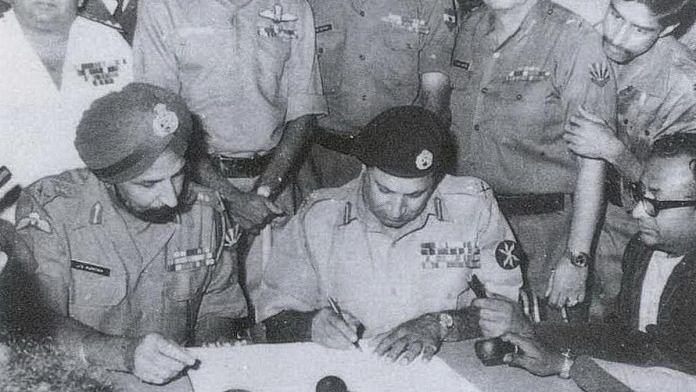New Delhi: On 16 December 1971, India won a decisive victory over Pakistan after a 13-day war that led to the creation of Bangladesh. While it was a short and decisive war, 4,000 soldiers were killed and more than 8,000 were injured.
On the war’s 49th anniversary, ThePrint’s editor-in-chief Shekhar Gupta unpacks the volatile decade of 1960s which preceded the war, in episode 641 of ‘Cut The Clutter’.
The 1971 war settled the problems for the people of East Pakistan, but did not solve India’s problem with Pakistan or Kashmir; in fact, it made the blood feud more intense, said Gupta.
“This gives us the lesson that wars rarely solve the central problem, even if they are decisive,” he added.
According to Gupta, the 1960s was a decade of wars in India that one should look back at, to understand present circumstances.
Also read: Indian Army’s dash to Dhaka in 1971 was operational brilliance. It holds lessons for Ladakh
Goa annexation, war with China and Pakistan
Soon after the Goa operation (annexation of Goa from the Portuguese) in 1961, the Chinese attacked India in 1962. Then, in April 1965, Pakistanis came knocking at India’s door in Kutch, Gujarat, said Gupta.
Pakistan brought their brigade of troops and tanks, but India tactically did not deploy heavy forces in that area, which led Pakistan to believe that India was incapable of fighting a war and thus launched a full-fledged operation to take Kashmir back from India.
However, Pakistan realised soon enough that they had miscalculated the calibre of the Indian Armed Forces. Pakistanis, then, had a big technological advantage, but they were not able to use it, noted Gupta.
On the ground, he added, the war was a stalemate. But in principle, even though India did not win, Pakistan lost because their only objective of taking away Kashmir was not fulfilled.
War with China, again
In 1967 came the big skirmish with the Chinese in the Nathu La pass in East Sikkim, which lasted a few days but was much more intense. The casualties on both sides were quite high.
But this taught India that they could withstand the Chinese and Chinese also learned that Indian Armed Forces were no longer a pushover.
During that decade, Naga insurgency was also at its peak.
In January 1966, Mizo insurgency also started and for the first time the government used the Indian Air Force against its own people.
Other separatist movements were also going on at the same time — Punjab and Haryana had separated in 1966 and the Dravidian movement in South India was also underway.
Also read: The 1971 Battle of Longewala: A night of confusion, Sam Manekshaw’s order, Pakistan’s folly
Lessons from 1960s
A lot of what is happening today has been determined by what happened during the 1960s, said Gupta.
India is currently going through its most insecure phase in history externally and internally.
“But to understand the crisis, we have to remember how we survived during the 60s. The second thing to remember is that even though a war is decisive, both the sides lose something, and war is a ‘messy business’,” Gupta added.
War also gives us an insight into the history, culture and ideologies of a nations, he noted
Ahmadiyyas in Pakistan are a minority and are not allowed to call themselves Muslims. And two war heroes from Pakistan were not celebrated as much just because they belonged to this community.
Gupta noted the Pakistan Army had occupied Chamb sector of Kashmir in both the wars.
In 1965, the commander was Major General Akhtar Hussain Malik who was an Ahmadiyya. But at that time when Pakistan had an advantage over India, President Ayub Khan decided to change the division commander and replaced Malik with Yahya Khan, who led the Pakistani army to surrender in 1971.
In 1971, Pakistan decided to attack Chamb again and the mission was brilliantly conducted. It ultimately broke Indian defences and Pakistanis captured Chamb again.
The operation was led by Major General Iftikhar Khan Janjua, who had also given India a “bloody nose” during the operation in Kutch, said Gupta.
However, he was an Ahmadiyya, too, and died in a helicopter crash during that war.
After the 1971 war, the Ahmadiyyas were victimised even more and then Prime Minister Zulfikar Ali Bhutto decided to take Pakistan towards more Islamisation.
While the creation of Bangladesh was a big success, after 1971, the re-Islamisation of Pakistan was a setback for the subcontinent, concluded Gupta.
Watch the latest episode of CTC here:







“On 16 December 1971, India won a decisive victory over Pakistan after a 13-day war that led to the creation of Bangladesh. While it was a short and decisive war, 4,000 soldiers were killed and more than 8,000 were injured”
I have never read something so disrespectful and misinformed. Please be respectful to a county’s history. Journalism is a big responsibility please research before writting anything.
The war was from march to December in 1971. Bangladesh fought really hard to win, and As grateful as we are for the help from our neighbor country for the last days and giving shelters to the ones who lost everything, But fact is fact.
It’s utterly disapointing to make our sacrifices as small as here.
How can country be born in 13 days?
Please I humbly request you to remove this, because of this article wrong search results are coming on google.
“India is currently going through its most insecure phase in history externally and internally.”……….. and media houses like The Print are doing their best to amplify it.
How ironic.